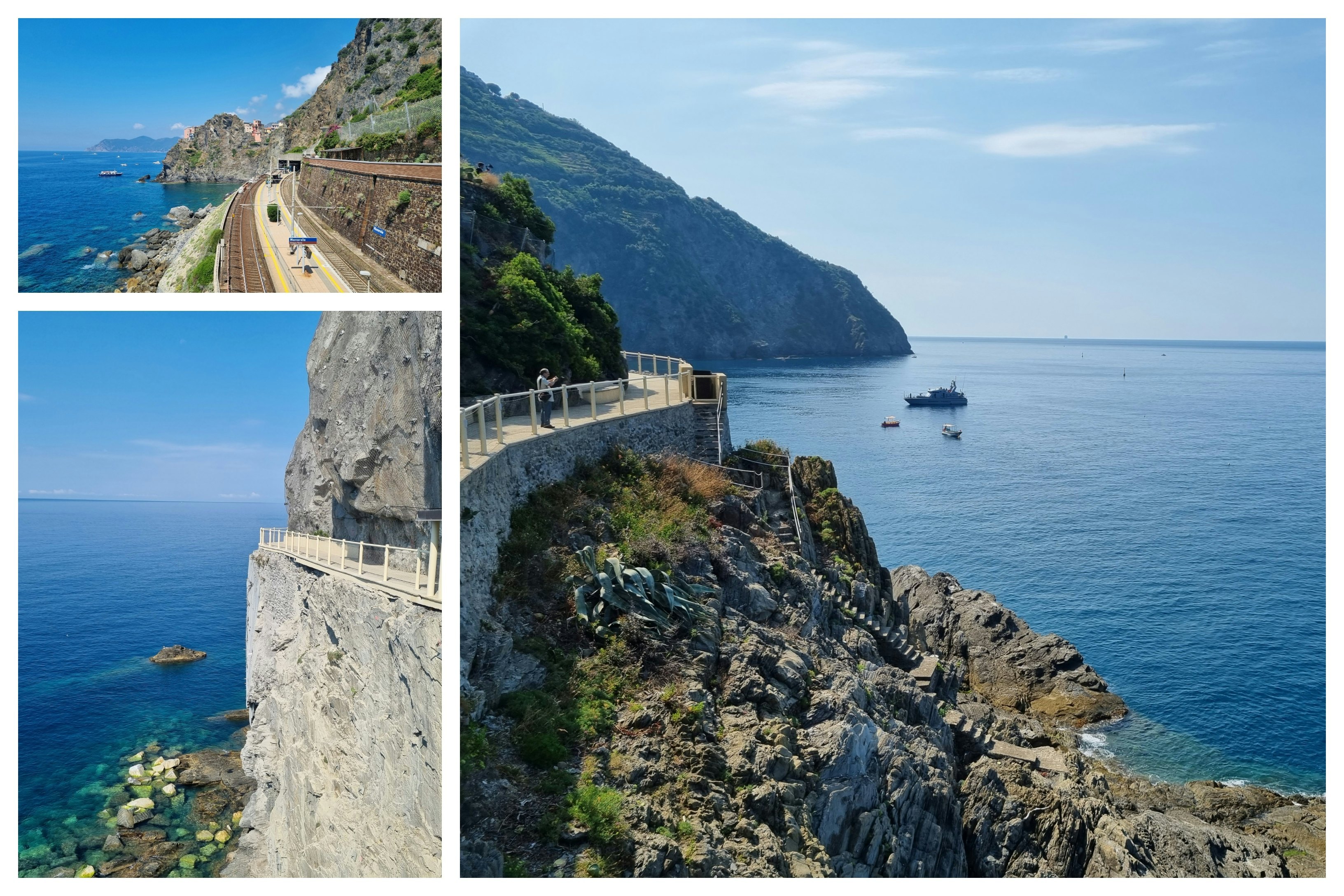
After a €22m ($25m) restoration project, the Villa dell'Amore footpath has been opened in Cinque Terre. Julia Buckley/Lonely Planet
It's a sunny Saturday morning on the Via dell'Amore. Lapping at the rocks, 30 meters below, is the bright jade Ligurian Sea. Cicadas are humming in the trees – wild olive and pine – sticking out from the cliffs. A gentle breeze is providing respite from the Mediterranean sun.
Since 1931, this has been one of Italy's most beautiful footpaths: 980 meters (3215 feet) of walkway etched into the cliffside of the Cinque Terre, the five remote seaside villages in the south of the Liguria region. Originally built to connect the villages of Riomaggiore and Manarola, over the past few decades, it has attracted millions of tourists to walk between the two, cantilevered high above the sea.
It became the highlight of the Sentiero Azzurro – the 12km (7.5 mile) network of coastal footpaths connecting the Cinque Terre villages. (The Sentiero Azzurro is a mere fraction of the paths in the area, however – there are 130km of walking trails in the Cinque Terre National Park.)
Such edge-of-the-world beauty carries real risks, however, and the Via dell'Amore was closed in 2012 after a rockfall injured a group of Australian tourists. Now, after 12 years, €23 million and 26,000 square meters of steel netting to prevent rockfall, the path has reopened.
Triumphant return
The Via dell'Amore reopened to all visitors on August 9, 2024. Access is via a one-way system, entering at Riomaggiore and finishing at Manarola.
So what's it like – and is it worth it? I was one of the first on the Via dell'Amore the day it opened, and it's a big YES. The path is breathtakingly beautiful, every step tells you about the unique landscape, geology and history of the Cinque Terre, and the engineering surely makes this a wonder of the modern world.
The path starts on the cliffside above Riomaggiore's train station, beside A Pié de Ma – one of the area's loveliest bars. The renovation work is immediately visible. The path is paved terrazzo-style, while the railings have been painted cream so they don't flash in the sun when visible from the sea. Even the steel netting that covers the eight hectares of rockface is relatively matte.
How to book
To book a visit, keep an eye on this website, which was not yet live at the time of writing. Tickets are €10 and must be booked as part of a Cinque Terre Card (at the time of writing, this wasn't an option on the website, but keep checking). The card is the daily pass that allows access to the paths and trains of the Cinque Terre. Visitors must book a timed entry slot – there will be 100 spots every 15 minutes between 8.30am and 7pm in summer or 5pm in winter. We recommend booking an earlier slot to beat the heat or a later one to snap photos in the glorious golden hour.
For those staying overnight in the villages, there is an option for after-hours access, but you will have to show a receipt of overnight tax paid.

What you'll see
The views out to sea, and backwards to Riomaggiore, are spectacular: you see the castle that tops the village, the entrance to Riomaggiore's sliver of a harbor, and the Santuario di Nostra Signora di Montenero, the blazing-white church up on high. Below you are the cliffs – layer upon layer of rock, laid one on top of the next like a lasagne. Lapping quietly at them (in summer) is the sea: limpid, Maldives-clear and a bright, rich jade in the sun.
Halfway along the path, you'll encounter a tunnel, which bids farewell to Riomaggiore as it winds round the cliff, passes benches built into the stone and patches of newly planted prickly pear and rosemary bushes, and twists around again. Now, the rest of the Cinque Terre comes into view: there's a glimpse of the colorful houses of Manarola on the next promontory, clifftop Corniglia beyond, and Monterosso's wide bay at the end of the landscape. Squint hard enough, and you might see Vernazza's ancient lookout tower, too.
From here, the path winds upwards and into an open-sided 'tunnel' dug through the rocks. This, the midway point between the two villages, is the most fragile part of the cliff face – it's where the 2012 rockfall happened. The engineers have taken no chances this time, blasting through the rock to extend the tunnel. It sounds ugly but is actually rather beautiful: the curving lines of the ceiling echo the cliff layers, which here arc up like waves. Inside the tunnel are panels relating the history of the path, and outside is a kind of botanical garden, suspended over the sea.

Downhill, ducking under a low outcrop and around the final major cliff, Manarola slides fully into view. The path ends above the train station, and a ramp takes you down to the village's famous tunnel through the cliff and into the village. What a journey – you can walk the Via dell'Amore in 15 minutes, but I took almost an hour. The beauty is off the charts.
That ramp down to Manarola is important. Crucially, this is the only wheelchair-accessible path in the Cinque Terre National Park – and the only one that's manageable for anyone with mobility issues (there's also an elevator at the Riomaggiore end). Cinque Terre is notoriously difficult to get around – the villages are stacked up the cliff sides – so the Via dell'Amore really is a way to get a taste of the area for those who can't manage more. For the first time in over a decade, visitors with mobility issues can get a true sense of the area.

Learn the history
Staff are stationed along the route to make sure visitors don't graffiti the rockface or affix 'love' padlocks to the railings as they did in the past – but they are also there to tell you about the history of the Via dell'Amore. This first part of the path was built in the 1920s by workers extending the local railway line. When they left, villagers decided to extend the path themselves. They chiseled a footpath along the cliffside, using dynamite to blast through bits of difficult rock. It was extremely intensive, dangerous work – but they did it to decrease their isolation. Until the railway was built in 1874, the only way to get between Riomaggiore and Manarola was to scale 600 steps over the cliffs.
What they achieved was a feat of engineering, even though they were working in their spare time. These modern consolidation works highlight what the villagers were up against. This time, specialist rock-climber teams had to drive nine-meter (30ft) anchoring studs into the rockface. Materials were brought in with helicopters. Geologists had to perform weekly checks, such were the "truly frightening conditions," according to the director of the works, Alessandro Focaracci.
The reopening, then, is not just beautiful for tourists, but importantissimo for locals. "Wonderful things happened on the Via dell'Amore," says guide Gianluca Pasini, who was born and raised in Riomaggiore. "The reopening is a really important moment for us. We all have beautiful memories – it's a route we always walked, as kids, as teenagers. In the 1990s, I remember concerts by the tunnel."
What to expect
How will it be with 100 people every 15 minutes? Busy, for sure. But there are so many places to sit, and so many vantage points, that there aren't any obvious pinch points at this stage.
Pro tip: If you want to experience it more peacefully, visitors staying in Riomaggiore or Manarola who book a daytime ticket will be allowed to return to the Via dell'Amore after closing time, alongside locals. That means you can see the magical sunsets with fewer people, or have dinner in one village and walk back to the other. The gates close at 1am and reopen at 7:30am for another hour of peace before the ticketed entry starts.
Locals aren't happy about it being gated off and closed overnight, but nobody can deny this is a jaw-dropper of an engineering project – and one of the most beautiful walkways in Europe, at least. Take your time and learn the history, and your enjoyment and understanding of Cinque Terre will rocket.







